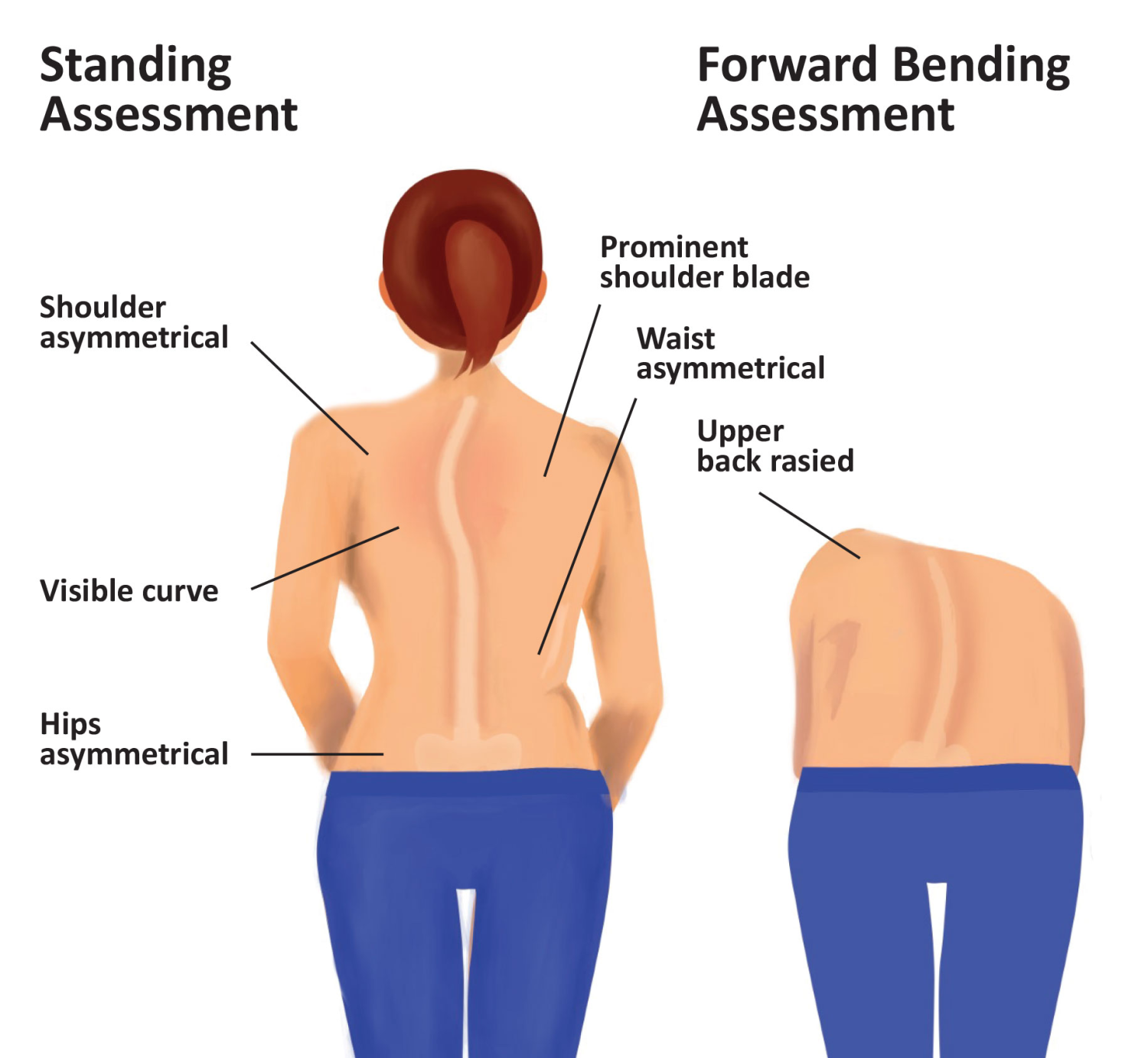Scoliosis (Idiopathic, Neuromuscular and Congenital)
Some people have extra curves in their back that curve side to side and rotate. This 3-D rotation and side to side curvature is called scoliosis. The provider will diagnose scoliosis using a physical exam, and an x-ray of the spine. The Standing Assessment and Forward Bending Assessment used in a physical exam are illustrated below.

On an x-ray, the spine of a person with scoliosis looks like an “S” or “C” instead of a straight line. Providers use a special measurement tool to measure the angle of the curve, called a Cobb angle. A slight curve may be normal. Scoliosis is diagnosed when the Cobb angle is 10 degrees or greater.
Scoliosis usually isn’t life-threatening or painful, and those who have it can live normal and active lives. While there are no known ways to prevent the development of scoliosis, early diagnosis and treatment can help prevent the condition from getting worse.
What are the types of scoliosis?
Scoliosis is fairly common. Approximately 3% of people have scoliosis. People with scoliosis did not do anything to cause the scoliosis. It is not from wearing a heavy backpack or from a “wrong” sleep position or from having poor posture. There is nothing someone with scoliosis could have done to prevent getting scoliosis.
There are three main types of scoliosis: idiopathic scoliosis, neuromuscular scoliosis, and congenital scoliosis.
Idiopathic Scoliosis:
In idiopathic scoliosis, the exact reason the spine curves is unknown. That's what "idiopathic" means -- we don’t know why it occurs. We know there is some basis in genetics. A recent theory involves the front of the spine growing faster than the back of the spine, causing a rotating and twisting of the spine.
Idiopathic scoliosis is categorized based on the age at which it begins:
- Infantile (IIS) less than 3 years old
- Juvenile (JIS) 4-9 years old
- Adolescent (AIS) 10 - 18 years old
Neuromuscular Scoliosis:
Neuromuscular scoliosis is associated with conditions such as cerebral palsy, spina bifida, muscular dystrophy, or spinal muscular atrophy, which lead to imbalances in the muscles that support the spine.
Congenital Scoliosis:
Congenital scoliosis is relatively rare and is the result of abnormal spinal developments before birth.
What are the signs and symptoms of scoliosis?
Most people with scoliosis do not report pain; those that do report pain, typically report only mild pain. Severe or constant pain is not a typical symptom of scoliosis.
You or your parent may have noticed one or more of the following changes in your appearance:
- Chest shifted to one side
- One shoulder blade more noticeable than other
- Asymmetry (unevenness) of the waist
- Clothes fit unevenly
- One shoulder is higher than other
- One hip is higher than other
- Asymmetry of front torso
- A curved spine that looks like an "S" or "C." rather than a straight line down the back
- Priminence of the ribs on one side
- Uneven waistline
- Twisted (also known as oblique) pelvis
- Signs of an underlying spinal defect, including light-brown birthmarks (also know as cafe au lait spots), hairy patches, dimples in skin on low back
- Unequal distances between the arms and sides of the body when a child stands upright or bends forward
You may not have noticed any changes in your appearance, but your healthcare provider did when you had your check-up. The diagnosis of scoliosis is made based upon a physical exam and x-ray of the spine.
Your provider may have asked you to do a forward bend exam, which can show spine abnormalities. This is called the Adam’s Forward Bend Test.
Learn more about some of the symptoms that can indicate scoliosis.
Scoliosis Resources
My Experience with Scoliosis
Hear firsthand from our spine specialists and our amazing patients and families as they discuss scoliosis and what to expect.
National Scoliosis Foundation
Find more information about scoliosis, including answers to common questions, a glossary of terms related to scoliosis and links to additional resources.
